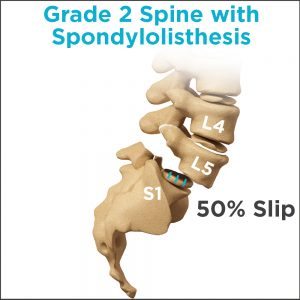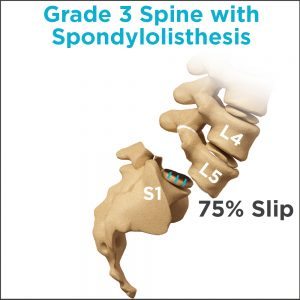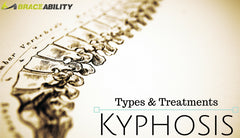Spondylolisthesis Grading: How to Diagnose and Treat Grades 1, 2, 3, 4 and 5
What Grade of Spondylolisthesis Do I Have?
Like many other conditions, spondylolisthesis can be measured using a grading system, where your spondylolisthesis grade is based on the degree of displacement of your vertebrae. Grades of spondylolisthesis influence what symptoms you might experience as well as what treatment you will likely receive.
Wondering what might be the cause of your spondylolisthesis? Read more about the causes and symptoms.
The grade of your condition is based on the distance from the posterior edge of the superior body of the vertebrae to the same edge of the inferior vertebral body. The ratings range from spondylolisthesis grade 1 to spondylolisthesis grade 5: grade 1 spondylolisthesis being least severe and grade 5 most severe. To diagnose this condition, your doctor will take X-rays in order to see if any of the bones in your vertebrae have slipped or are misaligned. They may order a CT scan or MRI to figure out how severe your slippage may be.
Do I Have Grade 1 Spondylolisthesis?

Grade I, or grade 1 spondylolisthesis is the least severe case. The degree of slippage for spondylolisthesis grade 1 ranges from 0%-25%. Grade 1 anterior spondylolisthesis usually occurs in the l4 on the l5 segment of the spine, which is connected, to your facet joints. Fortunately, spondylolisthesis conditions are typically not very severe, leaving grade 1 and grade 2 being the most frequent gradings.
Spondylolisthesis grade 1 treatment is typically using conservative methods since the slippage isn’t very severe. For starters, bed rest can help relieve your pain and take the extra stress off of your spine and back. In addition, try avoiding activities that may further your injury and slippage such as high contact sports.
Do I Have Grade 2 Spondylolisthesis?

Similar to grade 1, grade 2 is a low-grade spondylolisthesis. Grade ii spondylolisthesis degree of slippage is between 26% to 50%.
Spondylolisthesis grade 2 treatment is similar to grade 1, it starts with conservative methods such as resting, anti-inflammatory medications, and reducing the number of daily activities that may harm your back. Exercises and stretches for spondylolisthesis help strengthen the muscles surrounding your spine and is another great conservative treatment option.
Physical therapy works similarly. It helps to improve the strength and flexibility of your back and other parts of the core, which can reduce the amount of pressure the spine, endures. This ultimately relieves discomfort associated with grade 1 spondylolysis or spondylolisthesis grade 2 and helps slow additional slippage.
For those whose grade 2 spondylolisthesis condition doesn’t respond to such methods above or if you feel as though your condition is worsening, try bracing to help immobilize your spine. Such braces are usually used for individuals with 50% slippage or less.
Do I Have Grade 3 Spondylolisthesis?

Grade 3 spondylolisthesis tends to be on the more serious side of the spectrum. Grade iii spondylolisthesis slippage is between 51% to 75%.
Grade 3 spondylolisthesis treatment typically involves the same conservative methods mentioned above, but if your condition persists or get worse, surgery for spondylolisthesis is an option for this grade.
Before considering surgery for spondylolisthesis grade 3, it’s important to take in consideration:
- If your pain from spondylolisthesis has lasted for 6-12 months and has not improved
- If your slip is progressing
- If you are having trouble walking, sleeping, etc.
- If you are an obese individual, you may have a higher risk for surgery complications
Do I Have Grade 4 Spondylolisthesis?
Grade 4 spondylolisthesis goes along with grade 3 but is more severe. Spondylolisthesis grade 4 slippage is between 76% to 100%.
Treatment options for spondylolisthesis more commonly involve isthmic and degenerative surgery. Surgery for spondylolisthesis can help the instability in your spine as well as relieve compression that is being placed on your nerve roots.
Do I Have Grade 5 Spondylolisthesis or Spondyloptosis?

For grade 5 spondylolisthesis, your vertebra has completely fallen off the next vertebra. When the vertebra slides completely off the vertebra that is supposed to be beneath it, this is known as spondyloptosis.
For this rare condition, surgery is the only way to completely fix or heal spondylolisthesis of grade 5. Your surgeon may perform a vertebrectomy, which is an alternative procedure to help align your vertebra.






